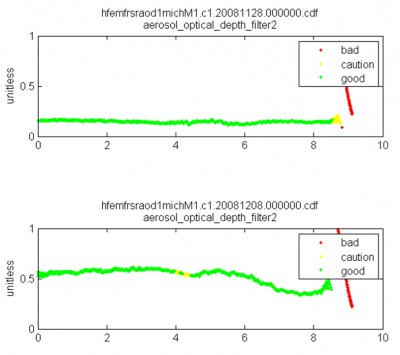
The AOD value-added product (VAP) provides both the wavelength-dependent values of AOD at five wavelengths (415, 500, 615, 675, and 870 nm) and the Angstrom exponent computed from 500 nm and 870 nm from the multifilter rotating shadowband radiometer (MFRSR) and normal-incidence multifilter radiometer (NIMFR). This VAP uses MFRSR-based algorithms originally developed by Michalsky et al. and has subsequently been applied to more than fifteen years of AOD measurements at the ARM Southern Great Plains (SGP), Tropical Western Pacific (TWP), and North Slope of Alaska (NSA) sites. Recently, these algorithms, which were specifically developed from data collected at the SGP, were tailored for use at diverse locations occupied by the ARM Mobile Facilities (AMF), including Steamboat Springs, Colorado, and Shouxian, China.
The datastream includes quality flags that have been used in the example plots to color the data values green for “good”, yellow for “caution”, or red for “bad” depending on the results of various quality tests outlined in the data file.
More information on AOD is available at the VAP web page. To access these data, log in to the Data Archive. (Go here to request an account.)

